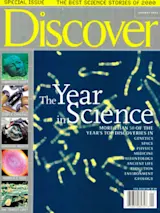Election Selection The scientists and mathematicians analyzing voting theory in "May the Best Man Lose" [November] are only beginning to scratch the surface of what it takes to reach a true consensus. As a mediator, I work with consensus every day. It is a much more subtle and intuitive process than any of the proposed mathematical models. I was glad to see Dana Mackenzie point out that the approval and Borda methods result from different theoretical constructs— one deductive and the other visual. Each method can produce results that are counterintuitive under some conditions. True consensus is the result of a much more complex system, which may include both of these constructs and many more. For example, although each voter may be able to rank choices 1-2-3-4, this ranking doesn't tell us the relative strengths of each voter's preferences. The consensus-building process requires each decision maker to weigh the preferences of every other decision maker as well as the reasons for these preferences. What is good for the decision makers as a group is also usually weighed against what is good for each of them individually.
Susan Cameron La Mirada, California
Mackenzie's article on voting methods was excellent, but it left out the voting system used in Australia. Although cumbersome and time-consuming, it has advantages not found in either the approval or Borda methods. All votes are first sorted according to voters' first choices. Then the candidate with the fewest votes is eliminated, and his or her votes are redistributed according to voters' second choices. Once again, the candidate with the fewest votes is eliminated, and his or her votes are redistributed according to each voter's next choice. The process continues until one candidate remains.
Consider also the remarkable proof by economist Kenneth Arrow. After postulating the basic properties that all voting systems ought to have, he then proved that no voting method can be constructed with all of those properties.
Harold R. Lindman Bloomington, Indiana
"Weighted" Borda count voting is yet another indication of voters' preferences. In this system, voters indicate relative weights for candidates in which the weights add up to 100 percent. For example, a voter may weight the candidates as follows: Gore 45 percent, Bush 35 percent, Nader 20 percent.
Note that a voter's relative weights implicitly determine the voter's ranking of the candidates— similar to the explicit ranking of the regular Borda count. But the weighted Borda count feels more in tune with "one person, one vote." Rather than seeming to vote for many candidates, as in the approval and regular Borda count methods, a voter distributes his vote based on the strength of his preferences.
Jason Cohen Tarrytown, New York
If voters were given a chance to express the strength of their preferences by, say, apportioning 10 votes among candidates, this would likely result in electing a candidate that some voters strongly favored and none had strong objections to. Intuitively, this seems preferable to the plurality system and the Borda count, both of which allow the voter only a one-dimensional expression. This system doesn't eliminate the danger of electing the worst man by dividing the vote of a majority among two other candidates. But it would open up the system to alternative candidates who are now out of the running because of our perceived need to vote for a "popular" candidate lest his strongest opponent, to whom we might object vehemently, be elected.
David C. Thomson Versailles, Kentucky
Universal Truths In "Why Is There Life?" [November] you mention

as a previously unsuspected force of antigravity. Didn't Einstein add the term

to his gravitational field equations and later recant it? Einstein's description sounds the same as Rees's: a very small, repulsive force that grows stronger with distance but with a negligible effect at distances less than billions of light-years.
Glen Woodard Enterprise, Alabama
Martin Rees responds:
Einstein introduced

because his equations didn't otherwise allow a static universe. When Edwin Hubble discovered that the universe was expanding, Einstein saw no further need for this number. Indeed, he termed it his "biggest blunder" because he might otherwise have actually predicted the expansion. But he wasn't as wrong as he thought. A repulsive force indeed seems to overwhelm gravity on the cosmic scale. Physicists attribute this to "dark energy" latent in empty space— Einstein's

in a more modern guise.
[Editor's note: Learn more about dark energy in next month's Discover.]
Where There's Smoke . . . Regarding "Nuclear Winter of Our Discontent" in your article "Twenty of the Greatest Blunders in Science in the Last Twenty Years" (October): We must point out that "dust" blown into the atmosphere is the smallest part of the nuclear winter effect, but that smoke is crucial. On this basis, the U.S. National Academy of Sciences and the International Commission of Scientific Unions, among other groups, critically reviewed the theory and concluded that the effect was credible. The years of research leading up to our 1990 Science article, to which you refer, provided additional support for severe environmental effects and did not disprove the theory, as you imply. For example, you quote from our article average temperature decreases of 36 degrees Fahrenheit as if these were trivial— a nuclear "autumn" rather than winter. People starving in the wake of crop failures would not be so sanguine.
Richard P. Turco Atmospheric Sciences, UCLA Los Angeles, California
Owen Brian Toon Laboratory for Atmospheric and Space Physics University of Colorado at Boulder
Thomas P. Ackerman Pacific Northwest National Laboratory Richland, Washington
Errata President Clinton's March 2000 announcement was for a proposed ban on MTBE ("Twenty of the Greatest Blunders in Science in the Last Twenty Years," October). There is no MTBE ban at this time.
The Graf Zeppelin photo on page 63 of our November issue should have been credited to E.O. Hoppe/Corbis.














